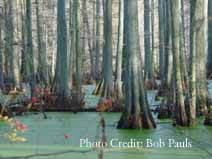 |
|
-July/August 2006- |
|
Cypress Mulch: Caveat Emptor
They may not look like anything more than a ghostly tree, but cypress swamps are in fact a unique and vital type of freshwater wetland. Like other wetlands, cypress swamps are biologically rich and diverse ecosystems; they provide environmental benefits that include purifying water, controlling floods, recharging aquifers and providing food and habitat for birds and other wildlife.
Swamp cypress are distinctly different from most other trees because they thrive in a water dominated environment; they can also live for over a thousand years. The "heartwood" of a mature (several hundred years old) tree is extremely durable. In the 1800s the durability and water-repellant properties of swamp cypress led to their commercial exploitation for lumber and mulch.
 Unfortunately, current harvesting practices have changed very little from those of last century. Unlike pine and other hardwoods, swamp cypress are not grown on plantations. Large areas are harvested by clearcutting; typically harvested areas are not replanted. Today cypress mulch is also produced in a non-sustainable manner. Originally, cypress mulch was made from the remnants of mature trees cut at sawmills; today because of the rising demand for this product immature trees are now routinely harvested and chipped solely for mulch.
Unfortunately, current harvesting practices have changed very little from those of last century. Unlike pine and other hardwoods, swamp cypress are not grown on plantations. Large areas are harvested by clearcutting; typically harvested areas are not replanted. Today cypress mulch is also produced in a non-sustainable manner. Originally, cypress mulch was made from the remnants of mature trees cut at sawmills; today because of the rising demand for this product immature trees are now routinely harvested and chipped solely for mulch.
In southern Illinois' Cache River Watershed lie some of our country's northernmost stretches of cypress swamps. As with the swamps in southeastern states, Illinois' cypress swamps were drained for agricultural and other development purposes and the cypress living in these unique wetlands ended up at sawmills. The rich biodiversity of Illinois' cypress swamps has been recognized by their designation as one of the world's "Wetlands of International Importance."* Currently, the Cache River Wetlands Joint Venture Partnership is working to establish a 60,000 acre wetland corridor of this vital ecosystem along the Cache River. Existing protected sites within this area include the Cache River State Natural Area and the Cypress Creek National Wildlife Refuge.
Many gardeners use cypress mulch because they think it lasts longer and repels water. However, because more and more mulch today is produced from immature cypress swamp trees, these favored properties are more a myth than reality. You can do your part to lessen the demand for this important natural resource by making "greener" choices for mulch; you may find that what you need is right at hand. Alternatives to using cypress mulch include
- Pine needles (great for acid loving plants)
- Chopped leaves
- Mulches made from plantation grown trees, such as pine and eucalyptus
- Mulches available from a landscape recycling center (made from local yard wastes)
For more information on Illinois' cypress swamps visit the websites for the Cache River State Natural Area (http://dnr.state.il.us/lands/landmgt/parks/r5/cachervr.htm) and Cypress Creek National Wildlife Refuge (http://www.fws.gov/midwest/CypressCreek/cachectr.html).
*This designation was made by the Ramsar Convention of the United Nations Educational, Scientific and Cultural Organization. View the list at: http://en.wikipedia.org/wiki/Ramsar_List_of_Wetlands_of_International_Importance.